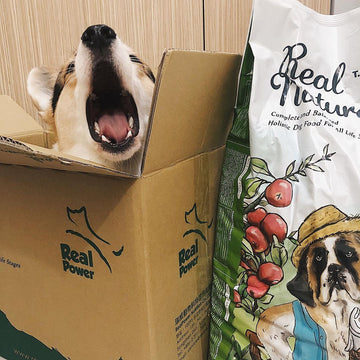Keep the pet FIT, Not Fat!

Fat pets are so cute!!
But did you know? Obesity may affect the lifespan of your pets!
Fat cats and dogs are high-risk groups for diabetes, chronic arthritis, and even skin diseases.
It can also easily lead to the deterioration of cardiovascular or respiratory system diseases.
When it comes to anesthesia, obese animals will also have a much higher anesthesia risk. [1]
To maintain a healthy posture of the pet, it is just like a human! #IncreaseMuscleAndReduceFat is the key!
Muscles can increase metabolism, burn fat, stabilize and support joints, and help pets run and jump more easily.
So, how should they eat to increase muscles? - Rely on animal protein!
To build muscle, protein is a vital role.
Protein is the raw material for muscles, and the ‘quality’ of protein is the key to whether muscles can grow efficiently.
When choosing dry food, the AAFCO standard is often primarily used, but is it enough just to follow the standard?
General analysis of certain pet food does not necessarily indicate the ‘quality’ of the food itself. For example, how does a product meet the AAFCO crude protein standard of 26%?
"fresh chicken" or "soybeans, chickpeas, peas, lentils" can both reach the criterion.
But!
These legumes-based plant proteins may not be as useful for cats and dogs as animal proteins. [2] Animal proteins are capable of providing amino acids that fulfill best the needs of pets. (Note 1)
For example, 'taurine', one of the essential amino acids for cats (Note 2), is something that we can’t obtain from plants.
Research also pointed out that when consuming the same amount of animal protein and plant protein, animal proteins help organisms convert into more weight gain, in other words, helps the pets grow taller and stronger! [3]
So, what kind of meat should be selected to help muscle grow best?
- BCAA (branched-chain amino acid)!
When it comes to muscle growth, it is inevitable to talk about BCAA! BCAA stands for “branched-chain amino acid”.
It refers to the three essential amino acids with branched structure: leucine, isoleucine, and valine.
Different amino acids create forms of protein, just like bricks with different colors and characteristics.
Together they build into houses with various functions: elastic muscle houses, thin and tough skin walls, multifunctional liver factories, etc.
But the eaten protein cannot be used directly by the body and needs to be broken down into small amino acids through the digestive organs and transported to various organs.
How are they used?
The body is smart. It investigates whether the owner is a couch potato, or if it lives in the Arctic where massive fat is needed, whether the owner is often stressed out, etc.
According to these living environments and habits, transport appropriate bricks to build houses with various functions.
So, what is so special about BCAA?
Generally, the bricks (amino acids) are transferred to the liver factory for modification and reorganization. Afterward, they will be transported to the whole body and only excess bricks (amino acids) are used to build the muscle houses.
BCAAs, as a special group of amino acids, skip the liver and are directly used to build the muscle.
When pets are running and jumping, the muscle houses will be destroyed and worn out under the expansion and contraction. The bricks or amino acids are sent to the muscles, and they will slow down the abrasion process and help repair them, making the muscle bigger and more beautiful! [4]
Even better, when “leucine” in BCAA reaches the muscle, it shouts like the supervisor "Hey! The bricks you want are here! Build the house bigger!"
Therefore, choosing foods rich in BCAA can help muscle growth and repair during and after activities in cats and dogs.
The following table compares BCAA among the commonly used ingredients in pet food.
At an equal dry weight, there can be a 5-time difference of BCAA amount between pea protein (most common-used plant protein in pet food) and animal protein.
▴BCAA content in vegetable vs. animal protein
|
|
Peas |
Soybeans |
Salmon♛ |
Eggs♛ |
|
Valine |
714 |
1852 |
2956 |
3083 |
|
Isoleucine |
524 |
1794 |
2599 |
2734 |
|
Leucine |
1106 |
3043 |
4593 |
3554 |
Unit: mg/100g dry weight, rounded to the nearest whole number.
Source: Food Nutrition Database, Food and Drug Administration, Ministry of Health and Welfare of Taiwan.
Conclusion!
To conclude the above articles, animal protein not only provides more complete nutrition for the pets, but it is also easier to be absorbed and used.
Among them, high-quality amino acid BCAA can directly provide muscle energy and increase exercise performance, BCAA is also one of the most important sources of protein synthesis for muscle growth.
When choosing a pet's diet, you can focus on the ratio of animal protein, especially the brands that focus on the ratio of amino acids.
Note 1: Amino acids are small molecules that makeup proteins. Different amounts and types of amino acids form into different types of proteins.
Note 2: The essential amino acids are the amino acids that the body itself cannot produce and must be obtained from food. Health problems can occur if long-term deficiency present.
References:
(1) German, Alex. "Obesity in companion animals." In Practice 32.2 (2010): 42-50.
(2) Mariotti, François. "Plant protein, animal protein, and protein quality." Vegetarian and plant-based diets in health and disease prevention. Academic Press, 2017. 621-642.
(3) Sarwar, Ghulam, et al. "Inter-and intra-laboratory variability in rat growth assays for estimating protein quality of foods." Journal of the Association of Official Analytical Chemists 67.5 (1984):
976-981. (4) Brestenský, Matej, et al. "Branched chain amino acids and their importance in nutrition." Journal of Microbiology, Biotechnology and Food Sciences 2019 (2019): 197-202.
(5) Yin, Jie, et al. "Branched-chain amino acids, especially of leucine and valine, mediate the protein restricted response in a piglet model." Food & Function 11.2 (2020): 1304-1311.
(6) Database of Taiwan Food and Drug Administration衛生福利部食品藥物管理署食品營養成分資料庫https://consumer.fda.gov.tw/Food/TFND.aspx?nodeID=178
Find out more about
Pet food myth busters #1: Is High protein always the best?
Pet Food Myth Busters #2: What is high proportion of fresh meat?

